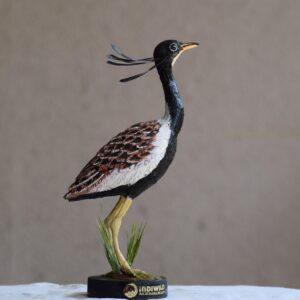Great Hornbill bird sculpture
The great hornbill is a large bird with a very large bill, which bears a sizable, brightly colored, horny growth known as the casque. The body is mostly black with a white neck, wing coverts, and flight feathers.
sculpture size 10 x 5 inch
Material Used : Polyresin
A resin sculpture is a statue or other piece of three-dimensional art that has been cast using fiberglass resin. Resin is a fairly lightweight, durable material that can be painted and glazed to look like stone, porcelain, bronze or marble. It is used to manufacture a wide variety of products
Click here to check other beautiful Sculptures on this website
The great hornbill (Buceros bicornis), also known as the concave-casqued hornbill, great Indian hornbill or great pied hornbill, is one of the larger members of the hornbill family. It is found in the Indian subcontinent and Southeast Asia.
Great Hornbill bird sculpture
Its impressive size and colour have made it important in many tribal cultures and rituals. The great hornbill is long-lived, living for nearly 50 years in captivity. It is predominantly frugivorous, but is an opportunist and will prey on small mammals, reptiles and birds.
The great hornbill is a large bird, 95–130 cm (37–51 in) long, with a 152 cm (60 in) wingspan and a weight of 2 to 4 kg (4.4 to 8.8 lb). The average weight of 7 males is 3 kg (6.6 lb) whereas that of 3 females is 2.59 kg (5.7 lb).[3] It is the heaviest, but not the longest, Asian hornbill.[3][4] Females are smaller than males and have bluish-white instead of red eyes, although the orbital skin is pinkish. Like other hornbills, they have prominent “eyelashes”.[citation needed]
The most prominent feature of the hornbill is the bright yellow and black casque on top of its massive bill. The casque appears U-shaped when viewed from the front, and the top is concave, with two ridges along the sides that form points in the front, whence the Latin species epithet bicornis (two-horned). The back of the casque is reddish in females, while the underside of the front and back of the casque is black in males.[citation needed]
The casque is hollow and serves no known purpose, although it is thought to be the result of sexual selection. Male hornbills indulge in aerial casque butting, with birds striking each other in flight.[5] The male spreads the preen gland secretion, which is yellow, onto the primary feathers and bill to give them the bright yellow colour.[6] The commissure of the beak is black and has a serrated edge which becomes worn with age.[citation needed]
The wing beats are heavy, and the sound produced by birds in flight can be heard from a distance. This sound has been likened to the puffing of a steam locomotive starting up. The flight involves stiff flaps followed by glides with the fingers splayed and upcurled.
The great hornbill is called banrao and homrai in Nepal, hence the name of the Himalayan subspecies, both meaning “king of the forest”. It is called “Vezhaambal” in Malayalam
A great hornbill named William was the model for the logo of the Bombay Natural History Society and the name of the society’s building. Norman Kinnear described William as follows in the obituary of Walter Samuel Millard:[44]
Great Hornbill bird sculpture
“Every visitor to the Society’s room in Apollo Street will remember the Great Indian Hornbill, better known as the “office canary” which lived in a cage behind Millard’s chair in Phipson & Co.’s office for 26 years and died in 1920. It is said its death was caused by swallowing a piece of wire, but in the past “William” had swallowed a lighted cigar without ill effects and I for my part think that the loss of his old friend was the principal cause.
The great hornbill is listed in CITES Appendix I. It has been assessed as vulnerable on the IUCN Red List of Threatened Species.[1] Conservation programmes have attempted to provide tribes with feathers from captive hornbills and ceramic casques to substitute for natural ones.[37]
In captivity
Very few hornbills are held in captivity, and few of them breed well. Females at the nests are extremely easy to capture, and birds caught in the wild are mostly female. Breeding them in captivity has been notoriously difficult, with fewer than a dozen successful attempts. Their extreme selectivity for mates and their long and strong pair bonds make them difficult to maintain for breeding.[38][39][40][41]
Great Hornbill bird sculpture
In captivity hornbills eat fruits and meat, a healthy diet consisting mostly of fruit and some source of protein. A few have been tamed in captivity but hornbill behaviour in captivity is described as highly strung. Captive specimens may bask in the sun with outstretched wings.














Reviews
There are no reviews yet.